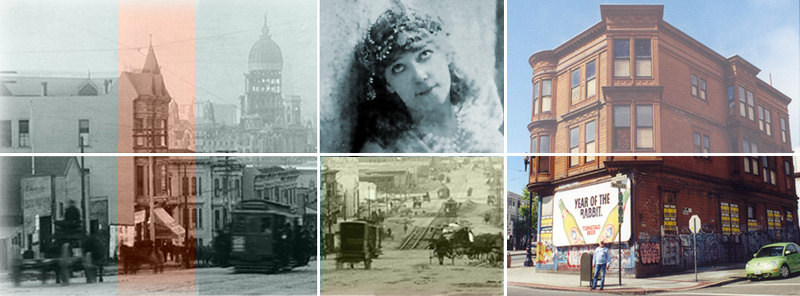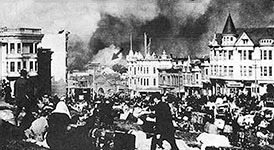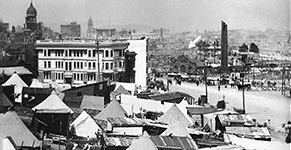

Built by Carmel Fallon, the niece of José Castro, former governor of Alta California and for whom Castro Street was named, this century-old building, a survivor of the quakes of 1906 and 1989, represents a rich chapter in San Francisco's history. Carmel had been married to Army Commander Thomas Fallon, who conquered San Jose for the United States in 1846 and later became mayor of that city. But when she found her husband in bed with another woman, Carmel beat the two offenders with an iron poker, and promptly divorced him.
With her six children Carmel eventually moved to San Francisco and established herself as a single business woman, demonstrating an independence that was rare for a woman of the nineteenth century. In 1894, she commissioned this combined commercial and residential building, as her new San Francisco family home. Designed by Edward Goodrich, a San Jose architect, it is trapezoidal in shape to conform to the oddly shaped lot formed by the intersection of Waller, Octavia, and Market streets. The Fallon Building uses classic revival elements, such as the ornamentation at the cornice and main entrance. All the rooms in the two upstairs flats fan out from a central stair court. The top floor stairwell was once crowned by stained and etched glass.
At the time of the 1906 earthquake and fire, a string of similar buildings stretched from the waterfront to this location, occupying all the "gore" lots on the north side of Market. The 1906 disaster destroyed all but this one. In fact, everything east of here on Market fell victim to that catastrophe. When the smoke had cleared, the Fallon Building marked the edge of the devastation. Family lore states that Carmel herself had helped keep the flames from taking her home. She was 79 years old at the time. Although the story can not be verified, it is certainly in keeping with this woman's indomitable character.
[CLICK TO ENLARGE] These photos show Market Street during the Great Fire of 1906 looking toward Valencia St. The Fallon Building would be on the left, down—just out of range. The grey arrow points to the Valencia Street Powerhouse as a point of reference.
Both Carmel and her Market Street home survived to become objects of contention. In 1911, Anita Fallon, the oldest of Carmel's children and a well-known stage actress, sued for custody of her mother, claiming that her brother was using hypnosis to control the 84 year old Carmel. That suit was withdrawn, but when Carmel finally died twelve years later, Anita filed a will naming herself as the sole beneficiary. This led to an intense family legal battle that was not fully resolved until the 1960s.
The Fallon Building was sold by Carmel's estate in the 1930s, reportedly to fulfill a financial pledge she had made to the capital fund for the Civic Opera House. Since then, the building has aged in place, the beneficiary of "benign neglect," which has meant that virtually nothing has been changed. One storefront is absolutely unaltered since it was built in 1894, an almost unheard of historical treasure. Most commercial storefronts are modernized at no more than 10 or 15 year intervals in order to keep them fashionably current for retail purposes.
The building was fully occupied until shortly before it was acquired by the Community Center Project in 1996. In the 1970s and 80s, it was the home of many gays, including artists and theater people. (See Into the Eighties for John Wullbrandt's account of this time.) In fact, this elegant survivor had gained a place in the heart of the community. This is why the community as a whole was delighted by its choice as the new Community Center and why resistance to its demolition has been so strong.
LANDMARK STATUS
On June 3, 1998, the San Francisco Landmark Preservation Advisory Board voted unanimously to recommend the Fallon Building be designated an official San Francisco landmark. Final approval by the Planning Commission, Board of Supervisors, and Mayor Willie Brown followed quickly. The Community Center Board withdrew its opposition as the result of negotiations with Friends of 1800 and San Francisco Heritage Foundation.
The California State Legislature awarded $1 million to the Community Center Project for the rehabilitation of the Fallon Building, and a ground breaking was proposed for October 20, 1999. The building was found eligible for inclusion in the National Register of Historic Places, through an Area of Potential Effect (APE) undertaken for the Central Freeway Project. In October of 1998, the Friends of 1800 Market were honored by the National Trust for Historic Preservation's GL Preservation committee during the National Preservation Conference in Savannah.
In 1999, the California State Legislature awarded $1 million to the Community Center Project for the rehabilitation of the Fallon Building. Vice President Al Gore acknowledged the Fallon Building as a Save America's Treasures site, a program administered by the National Trust. The Fallon Building's this valuable historic structure was restored, and remains to testify for future generations about its own colorful past and San Francisco's.
TIMELINE 1894-2002
1894 Fallon Building built by Carmel Fallon, legendary granddaughter of General Joaquin Ysidro Castro and niece of José Castro, former governor of Alta California.
1906 Saved from the April 18 Earthquake and marked the point where the Great Fire was halted.
1975 Became home to many Gays, art events and publications continuing into the 90's.
1996 Purchased by Lesbian Gay Bisexual Transgender Community Center Project.
1997 Friends of 1800 formed to prevent destruction of the Queen Anne Victorian.
1998 Saved from demolition and formally recognized for outstanding preservation achievement by Gays and Lesbians at the National Trust for Historic Preservation Conference in Savannah. Designated Official San Francisco Landmark #223.
1999 Acknowledged by Vice President Al Gore as a Save America's Treasures site, a program administered by the National Trust. Ground breaking October 20 marked the beginning of the restoration of the Fallon Building and construction of the Community Center.
2002 LGBT Community Center opens.

